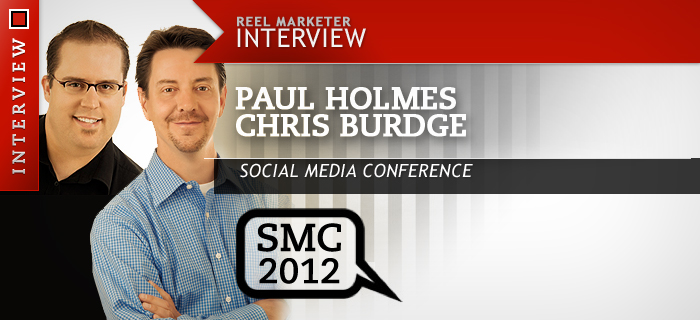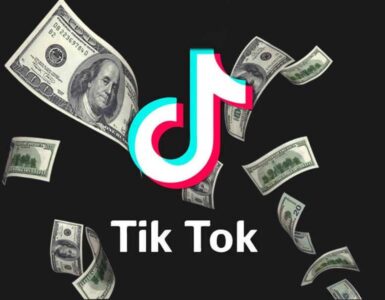Social Media Camp conference founders Paul Holmes and Chris Burdge share their insights regarding social media and video marketing in this duo-interview. Both web-marketing pioneers, they've been privy to many online developments long before they became mainstream. With video marketing taking it's place on stage at the Camp this year with online content creator and former CBC host Jenny Baik, and others, it's certain to be a value-laden conference:
Welcome! What are you each known for in the online business world?
CHRIS BURDGE: I have been creating online marketing strategies for clients since 1994. This actually pre-dates the world wide web back when I was developing campaigns on a BBS (Bulletin Board Service) for members of the American Chamber of Commerce in Japan. What I'm best at, and therefore known for, is helping companies use online marketing, particularly social media, to effectively grow their businesses. In some cases that means acquiring new customers, in others it's increasing share of wallet or decreasing costs by improving operational efficiencies.
In terms of social, I started pitching companies on social media in 2008 but it was too early. Many were interested in what social media was but none were ready to allocate budget towards it. By late 2009 things were starting to change. That's when I approached Paul with the idea of Social Media Camp. I saw how excited people were about WordCamp (a one-day event focused on WordPress blogs) and knew that a broader conference dedicated to all aspects of Social Media would catch fire.
PAUL HOLMES: I've been a fan of communications technology since as long as I can remember, from running my own BBS when I was 14, to using the Internet long before there existed a World Wide Web. Almost predictably, I became an early adopter and advocate of Social Media, shortly after the public launch of Twitter. I was memorized with the possibilities this new medium brought, and have thoroughly enjoyed watching it evolve. Through my advocacy, I started organizing events and getting invitations to speak from a myriad of places. This all led up very naturally to the launch of Social Media Camp.
My career in IT spanned 21 years, and included starting, running and selling a number of businesses. Now that I am no longer working directly in IT, I have the luxury of seeing Social Media the way the rest of the world sees it – as a tool to connect. IT no longer holds a monopoly, now everyone can be a geek!
Together you founded Social Media Camp – What lead to it being created?
 PAUL HOLMES: Social Media changes everything, and has infiltrated every part of our society. There was an urgent need for people to learn how to use this technology more effectively. As with any technology of this magnitude, there is a great deal of anxiety, and a great deal of excitement. A conference seemed like a logical need, and we discovered quickly that we weren't far off the mark. Moving forward, we see Social Media Camp as a coming together of not just people from our area, but from around the world. We want to bring the greatest minds here, and show the world that the City of Victoria (BC, Canada) is not only a beautiful place, but a destination for forward thinking technology.
PAUL HOLMES: Social Media changes everything, and has infiltrated every part of our society. There was an urgent need for people to learn how to use this technology more effectively. As with any technology of this magnitude, there is a great deal of anxiety, and a great deal of excitement. A conference seemed like a logical need, and we discovered quickly that we weren't far off the mark. Moving forward, we see Social Media Camp as a coming together of not just people from our area, but from around the world. We want to bring the greatest minds here, and show the world that the City of Victoria (BC, Canada) is not only a beautiful place, but a destination for forward thinking technology.
CHRIS BURDGE: While I suppose social media is “maturing” it seems to be growing and changing as fast as it matures. SMC is even more relevant and necessary today than it was 2 years ago, which is why it continues to grow in both size and scope. I'm really, really excited about the line-up we have for this year and what is going to come out of the intersection of the speakers, trainers, workshops, awards and hundreds of people and businesses hungry to learn, use, network and grow!
Largely in part to social media, the online video medium is developing rapidly – in what ways are corporate social media trail blazers using video effectively? CHRIS BURDGE: Indeed, online video is maturing, and being used much more by businesses of all sizes. The increased usage is due to a combination of video being much cheaper to produce, and the ubiquity of video capable devices like the iPhone, Blackberry and Flip – not to mention social media making the spreading of videos to 1,000's of people as simple as a mouse click! Video is quickly becoming the most popular content on Facebook, Twitter and Google+!
CHRIS BURDGE: Indeed, online video is maturing, and being used much more by businesses of all sizes. The increased usage is due to a combination of video being much cheaper to produce, and the ubiquity of video capable devices like the iPhone, Blackberry and Flip – not to mention social media making the spreading of videos to 1,000's of people as simple as a mouse click! Video is quickly becoming the most popular content on Facebook, Twitter and Google+!
Two “corporate social media trailblazers” that come to mind in locally are Liquor Plus and the Long Beach Lodge.
I like what Rod Phillips ( @Rod_Philips ) at Liquor Plus has been doing. He developed a video channel for the retail business he calls “LP TV” which is published to their website as well as their Facebook page and of course the Liquor Plus YouTube Channel. He uses video to help viewers understand wine as well as discover new products and find the right pairings to meet their needs.
Perry Schmunk ( @perryschmunk) General Manager at the Long Beach Lodge in Tofino, BC, is a social media trailblazer that has incorporated video very effectively to create an emotional response to their beautiful location and the “memories” created by families that stay there – see their YouTube Channel. Perry also uses video to demonstrate the personal touch one can expect at this 60 room resort on the shores of Tofino with his in-person blog style videos:
PAUL HOLMES: I think immediately of the “Old Spice Guy” campaign. As you've covered in previous Reel Designer interviews, the television (and online) ads had the actor shirtless on a horse andwith diamonds in his hands – all very memorable. The interactive video campaign which followed was the most impressive combination of an “old media” campaign with a “social media” angle. The towelled fellow created several videos in response to Tweets, Facebook posts, YouTube comments and so forth. At one stage, he and celebrity Alyssa Milano engaged in several video tete-a-tete's that struck the viewer as not only hilarious, but genuine and unscripted (and perhaps they were, who really knows)!
It will be hard to recreate the magic of this campaign. The last vestiges of “old media” audience concentration certainly helped, and this is disappearing rapidly with the movement away from television, or toward PVR recording of television. By introducing a character that was already familiar to many audiences, and because of the originality of the campaign concept, it also became newsworthy, which contributed greatly to it's success.
Old Spice is the most consistent example of successful video marketing we get! Moving on, how has video become a more viable marketing medium for both SME (Small to Medium Enterprises) and mom-and-pop operations?
PAUL HOLMES: The expectation of perfection doesn't wear on small enterprises the same way it does on large corporations. If a corporation produces something that's unpolished and “folksy”, it just doesn't seem to work as well. Of course, the real answer to the question is that the tools have become stunningly cheap to afford and simple to use, thus making video a accesible medium for nearly everyone with an internet connection and a camera.
CHRIS BURDGE: Paul nailed it there. Having said that sometimes the simplicity of making a thing can make people lackadaisical – case in point the flashing text and animated GIF images of the late 90's when everyone wanted to be a web developer. The same could happen to video because it's so easy to create. The sheer volume of video will make it even more important to have a strong “on camera presence” with good quality audio and lighting. Good content is table stakes – sure, you may get someone to pay attention once. But it's great content that will keep them coming back for more.
Is there a video using social media example each of you can refer to that a presenter at SMC has personally/professionally used?
CHRIS BURDGE: As I touched on earlier, Perry from Long Beach Lodge was one of the panelists on the “Tourism” panel at Social Media Camp 2011. He talked about how they have maintained an occupancy rate way above industry average with an effective social media strategy of which video plays a major role. Their latest video “Come on By” has already been viewed over 1,100 times in two months (in their slow season), not too shabby for a reasonable small resort on Vancouver Island.
This year we are very excited to have CBC TV Host and Journalist Jaeny Baik ( @JaenyB ) doing a 90 minute workshop at Social Media Camp in June 2012 focussing on “On Camera Coaching and Video Marketing Strategy”. I love this very simple video Jaeny made of “How to Walk and Talk on Camera”:
With Google flexing its reach, how should an organization start relationship building using Google+ to integrate their current and future YouTube content?
PAUL HOLMES: Google+ is busily tracking all the shares of your video. It's my guess that having a bunch of legitimate shares (or +1's) on Google+ for your video can't possibly be a bad thing. Of course, the +1 button is already available on YouTube (click “Share” first). It will be interesting to see if Google attempts to marry the “Favorite” and “Like” features more, considering all the options: Like, Dislike, Add to Favorites (or another list), Subscribe, Add Friend (now “Add Contact”), and Share (which allows you to post to 10 networks, including Google+). This side of video marketing has to be just a bit daunting for the beginner marketer.
CHRIS BURDGE: Originally a skeptic, I'm quickly becoming a huge fan of G+ (Google Plus). I'm really enjoying Google Hangouts and what you can do with them – I'll explain more in a bit. I see they've incorporated a YouTube tab into the right column making it very easy to embed YouTube content into your G+ posts and I'm sure they will continue to make that even easier.
The big story about Google Plus for me is its effect on search. My Google Plus brand page is already in the #1 spot in natural search results after only a few weeks, ahead of my LinkedIn account which is more than 5 years old. Google is definitely giving its own content preference. Those in the know will be able to leverage that for competitive advantage and video, especially YouTube, will only be gravy on this already delicious meal.
When working with either a professional video production company or a creating a (DIY) do-it-yourself video project, what are some key points to bear in mind to best make sure an engaged audience with video?
CHRIS BURDGE: Like anything else on the web – content is king. So whether you're working with a professional or going DIY it's critical to spend time developing a strategy and great content. That starts with knowing who your audience is and creating for them. Your language, dress, tone and manner and location should all cater to your customer. If you're a social media trainer catering to newbies don't throw around terms like G+, Edgerank and Klout score – unless of course you're explaining what they are – the viewer won't know what you're talking about, they'll feel dumb and will figure that's how the rest of their experience with you will go.
Aside from that, it's important to have good audio quality. Actually that can't be over-emphasized. There's nothing worse that spending all kinds of time and energy producing great content and then shooting a video that can't be heard because the microphones aren't close enough or there's background noise.
PAUL HOLMES: I concur with Chris on the importance of audio quality. It's often what sets apart the good and bad videos online. No viewer can tolerate a video with terrible audio for very long. The same can be said about shaky cameras; if you're going to do-it-yourself, invest in a camera tripod and use it whenever possible.
Some other tips for do-it-yourselfers is to capture in the right light, ensure the subject is in the frame, and take a sample shot and play it back before filming the whole sequence so you know if it's all working as it should.
Also, while a VLOG (video blog) style format is fine, it's a bit tedious to fill an entire channel with this style of content. Try mixing it up with interviews, top 10 lists, or some other formats to keep people's interest.
Taking a stab at the future, what trends would you say we may expect with social video? It took a while for twitter to ‘be a fit' in the mainstream. What are some companies we should keep tabs on?
PAUL HOLMES: Why does anybody send a text message instead of making a phone call? Question our assumptions – we need to look at the same human psychology when asking why somebody would send a Tweet instead of making a video (if indeed both were just as simple, and they will become so). I suspect there is room for both in the social universe, and there is little doubt video will continue to increase in popularity. Although there are many companies that have and will continue to make strides in this area, I suspect the big players in social will be the likely big hitters. With the advent of Google+, and the muscle of YouTube (consider their recent foray into pay services as a gauge of their interest in innovating), I really think Google is the odds on favourite to dominate the “Twideo” space. But don't count out the other big players, including Facebook and Twitter. Of course some other players will come, and could turn my prediction on its head. I think they would do this by establishing a strong, loyal following, and getting noticed for doing so (much as Twitter did).
CHRIS BURDGE: When you talk about video most people think about recorded videos. There are certainly going to be more companies doing interesting things with recorded video.
What I really excited about is where live video calling is going. I think live video is set to explode in terms of usage by individuals and companies. The launch of Google Plus' “Hangouts” and Facebook's integration of Skype has made it much easier to connect with friends and colleagues by video. I especially like G+ hangouts for its simplicity, additional features like white-board and screen sharing and multi-person video calls (up to 10 people). I have created a social mentoring group and we use G+ Hangouts to meet once a week. Its awesome.
Tell us about what to expect at Social Media Camp 2012!
CHRIS BURDGE: We are bringing many of them together next June to offer an intensive 2-days of exploring, learning and sharing social media across all industries from small business to non-profit, corporate, government, media, the arts and education. SMC 2012 on June 8th and 9th will be our third annual SMC. Each year we build on the success, energy and creativity of the previous year. There are so many incredibly talented and creative speakers, teachers and visionaries.
The highlight of SMC 2012 is our keynote speaker, New York Times Bestselling author and AdAge Power150 Top5 blogger, Chris Brogan. Tickets are now on sale SocialMediaCamp.ca
PAUL HOLMES: Chris has said it well. I'm excited about Social Media Camp because it's a truly exciting opportunity to meet amazing people who are talking about creative and interesting things.
Dearer to my heart, though, this event has put Victoria on the map as a leader in Social Media in North America – not only are we an amazingly beautiful city, but we are a city with a thriving technology sector, and forward-thinking leaders in Social Media.
This year, we will truly be inviting the world to come and experience Victoria. People will share, learn, connect, grow and find new opportunities and new ideas. And they will leave with fond memories of an amazing place doing amazing things.
Visit Social Media Camp 2012: http://www.socialmediacamp.ca/






Loving these wonderful social-engagement examples. Thanks for the article!